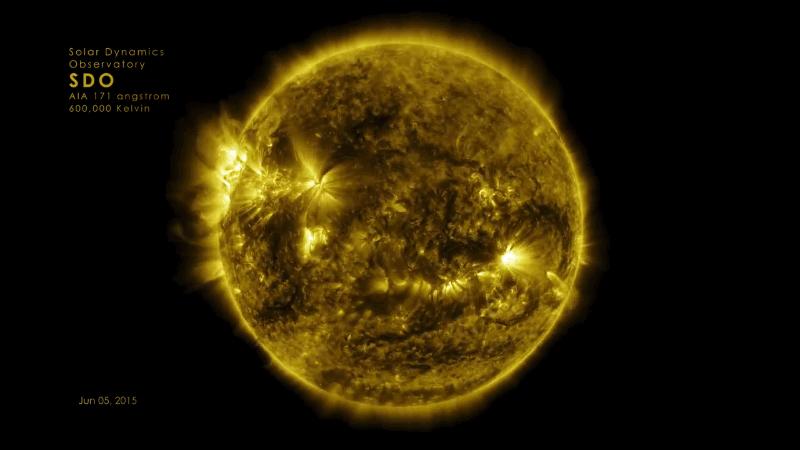sdo
Latest

One-year timelapse video of the sun shows its dancing corona
NASA's Solar Dynamics Observatory was only designed to fly for five years, but it has celebrated six years of 24/7 solar observation on February 11th. The ultraHD video below the fold is a timelapse that stitches together images the spacecraft captured during that sixth year, from January 1st, 2015 to January 28th, 2016. Since each frame represents two hours and the photos were taken in extreme ultraviolet range, you can clearly see the sun's corona dancing and undulating throughout the video.

ICYMI: Obstacle-avoiding UAV, smartwatch whys and more
#fivemin-widget-blogsmith-image-421365{display:none;} .cke_show_borders #fivemin-widget-blogsmith-image-421365, #postcontentcontainer #fivemin-widget-blogsmith-image-421365{width:570px;display:block;} try{document.getElementById("fivemin-widget-blogsmith-image-421365").style.display="none";}catch(e){}Today on In Case You Missed It: A new wearable screen that runs Android while strapped to your wrist is out, but we can't help but make fun of it. MIT's Computer Science and Artificial Intelligence Lab created a UAV that can fly through a forest safely with an obstacle avoidance algorithm. And a prototype gun for objects lets users whip together large-scaled 3D designs using run-of-the-mill packing tape.

Earth's orbiting observatories and their literally awesome images
While the Voyager 1 probe, launched in 1977, cruises into interstellar space (the farthest man-made object from Earth) and missions like New Horizons capture snaps from the outskirts of the solar system, we've been keeping the heavy hitters close to home. Massive space telescopes that scan the cosmos with augmented eyes have been orbiting the Earth for years to get a clear view of the universe without atmospheric distortion. The Hubble Space Telescope's 1990 launch set a new precedent for these space-based observatories in terms of scale and abilities. These new instruments have helped scientists gather an incredible amount of data and mind-bending photos from deep space. With Pluto hogging the spotlight lately, we decided to take a look back at some of these powerful orbiting eyes and their visual achievements. [Image credit: JPL]

The Big Picture: Catching an intense solar flare in action
It's no longer rare to hear reports of solar flares that could affect Earth, but seeing them in vivid detail? That's another matter. Thankfully, NASA's Solar Dynamics Observatory recently captured a high-intensity X1.8 flare (80 percent more intense than an already huge X1 flare) in action. The pretty pyrotechnics you see above represent a subset of the ultraviolet light from the eruption, while the video below shows what it looked like in other wavelengths. And the kicker? As impressive as this may be, it's far from the largest example in recent memory -- that honor goes to a mammoth X28+ flare from 2003. These ejections aren't so enjoyable when they cause havoc with communications and navigation systems, but they at least make for a good light show.

Alt-week 9.8.12: Moon farming, self powered health monitors and bringing a 50,000 year-old girl to life
Alt-week peels back the covers on some of the more curious sci-tech stories from the last seven days. Some weeks things get a little science heavy, sometimes it's a little on their weird side, and there's usually a bit of space travel involved, but these week's trend seems to be "mind-blowing." Want to grow carrots on the Moon? We got you covered. How about bringing a 50,000 year-old ancient human back to life? Sure, no biggie. Oh but what about a solar eruption that reaches some half a million miles in height. We've got the video. No, really we have. Mind blown? This is alt-week.

Summer-loving NASA engineers launch SDO probe to worship the sun (video)
Say all you want about how bad your local forecast is, it's way more accurate than our local solar forecast. The last time we checked, solar storms are said to knock out GPS temporarily sometime in the next two years -- the kind of window that would make even the most suave meteorologist smirk. With the launch of the new Solar Dynamics Observatory we're hoping NASA can shrink that window down by, oh, at least a few months. The probe lifted off yesterday, perched atop an Atlas V rocket, and is now orbiting Earth. There it will study our sun with a series of optical and magnetic sensors, beaming data back at a rate of 150MBit/sec, making us ever so slightly jealous that this thing can get a better signal in space than we can down here on the surface. The launch fireworks are embedded below for those who weren't glued to NASA TV yesterday morning. [Thanks, Pavel]





